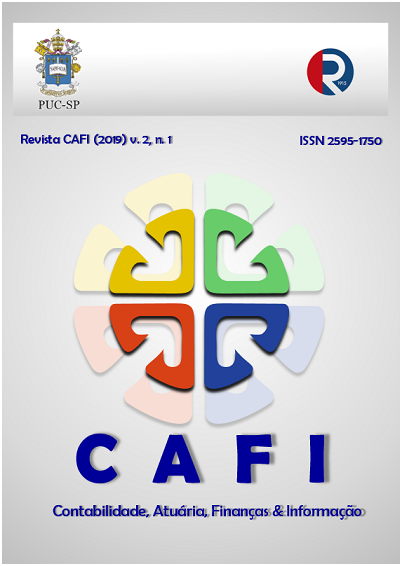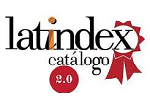Estudo comparativo entre a Adidas e a Nike sob o enfoque do ambiente Lean: manufacturing e accounting
DOI:
https://doi.org/10.23925/cafi.v2i1.40912Resumo
Este artigo trata dos conceitos de Lean Manufacturing ou Manufatura Enxuta e Lean Accounting ou Contabilidade Enxuta. A realidade atual apresenta mercados altamente competitivos e a busca incessante de melhoria de desempenho por parte dos gestores, visando melhores margens de lucro e redução de desperdícios. Tais práticas resultam, consequentemente, na diminuição de custos e em melhor retorno para os negócios. A delimitação do estudo ocorreu mediante a escolha de duas empresas que ocupam posições de destaque no setor de artigos esportivos: Nike e Adidas. Uma análise comparativa entre tais empresas, visto que há a adoção da fabricação enxuta apenas na Nike. A observação comparativa mediante os demonstrativos contábeis de ambas as empresas evidenciou melhor eficiência para a empresa com cultura lean. Portanto, o presente artigo consegue evidenciar resultados positivos por meio da adoção do Lean Manufacturing concomitantemente ao Lean Accountig como opções e diretrizes para a redução de desperdícios e melhor desempenho operacional que decorrem em resultados monetários melhores as organizaçãoes que decidem pela adoção a fabricação enxuta, com a implementação de novas práticas ao negócio.
Referências
Atkinson, Anthony A.; Banker, Rajiv D.; Kaplan, Robert s.; Young, S. Mark. (2011). Contabilidade Gerencial. 3 ed . São Paulo: Atlas.
Carbonera, Normides J.. Lean Enterprise: an Innovation on the controllership, accounting organizations and society. (2012). Disponível em: https://www.lean.org.br/artigos/185/a- controladoria-na-lean-enterprise.aspx. Acesso em 12/11/2018.
Cunningham, Jean. Realidade dos Demonstrativos de Resultados Financeiros Lean,
International Journal of Operations & Production Management. (2012). Disponível em https://www.lean.org.br/artigos/193/A-Realidade-dos-Demonstrativos-de-Resultados- Financeiros-Lean.aspx?utm_source=leanshop-artigos&utm_medium=link-detalhe. Acesso em: 11/11/2018.
Dowbor, Ladislau. (2016). O Pão Nosso de Cada Dia. São Paulo: Perseu Abramo.
Gil, Antonio Carlos. (2010). Como elaborar Projetos de Pesquisa. 5 ed. São Paulo: Atlas,2010.
Gracanin, Danijela; Buchmeister, Borut; Lalic, Bojan. (2014). Using cost-time profile for value stream optimization. Procedia Engineering, 69, 1225-1231. Disponível em:
<https://www.sciencedirect.com/science/article/pii/S1877705814003592>. Acesso em: 01/11/2018.
Hansen, D. R.; Mowen, M. M.; Guan, L. (2009). Cost management: accounting and control. 6. ed. Mason, OH: South-Western College Pub.
Hines, Peter.; Taylor, David. (2000). Going lean: a guide to implementation. Cardiff: Lean Enterprise Research Center. Disponível em:
<http://www.scielo.br/scielo.php?script=sci_nlinks&ref=000185&pid=S0104- 530X201400010000400019&lng=pt.> Acesso em: 10/11/2018.
Horngren, Charles T.; Sundem, Gary l.; Stratton, William O. (2008). Contabilidade Gerencial. 12 ed. São Paulo: Pearson, 2008.
Jiambalvo, James. (2009) Contabilidade Gerencial. 3 ed . Rio de Janeiro: LTC.
Jones, Daniel T. (2011). As Consequências Financeiras Lean. Disponível em:
<https://www.lean.org.br/artigos/153/as-consequencias-financeiras-do-lean.aspx>. Acesso em: 08/11/2018.
Jusko, Jill. (2007). Accounting for lean tastes. Industry Week. Disponível em:
<https://www.industryweek.com/software-amp-systems/accounting-lean-tastes>. Acesso em: 05/11/2018.
Katayama, Hiroshi.; Bennet, David. Lean production in a changing competitive worlds: a Japonese perspective. International Journal of Operations & Production Management, v.16, n. 2, p. 8-23, 1996. Disponível em: https://waseda.pure.elsevier.com/en/publications/lean- production-in-a-changing-competitive-world-a-japanese-perspe. Acesso em: 02/1/2018.
Kee, R.; Scimidt, A. Comparative Analysis of Utilizing Activity-Base Costing and Theory of Constraints for Making Product-mix decisions. International Journal of Productions Economics. (2000). Disponível em https://pdfs.semanticscholar.org/113b/4f39ef713b1c5578081816a02ae15c68a54e.pdf. Acesso em: 30/10/2018.
Leach, Adam. (2012). Nike reduces lead times through lean manufacturing. Disponível em:
<https://www.cips.org/en/supply-management/news/2012/may/nike-reduces-lead-times- through-lean-manufacturing/>. Acesso em: 11/11/2018.
Lean Accountants (2012). Nike Reports Lean Production Success. Disponível em:
<https://www.leanaccountants.com/2012/05/nike-reports-lean-production-success.html>. Acesso em: 11/11/2018.
Lopez, Patix r. A.; Santos, Jordy F.; Cuatrecasas, Arbós L. (2013). Lean manufacturing:costing the value stream . Industrial Management & Data Systems, 113, v5, 647-688. Disponível em:
<http://dx.doi.org/10.1108/02635571311324124> Acesso em: 08/11/2018.
Malta, João; Cunha, Pedro F. (2011). A new approach for cost modelling and performance evaluation within operations planning. CIRP Journal of Manufacturing Science and Technology. Disponível em: <https://www.sciencedirect.com/science/article/abs/pii/S175558171100068X> Acesso em: 12/11/2018.
Máquina do Esporte (2018). Adidas supera 20 bilhões de euros em vendas com Reebok, EUA e China. Disponível em: <https://maquinadoesporte.uol.com.br/artigo/adidas-supera-20- bilhoes-de-euros-em-vendas-com-reebok-eua-e-china_34137.html>. Acesso em: 11/11/2018.
Mundo das Marcas. (2006). Nike. Disponível em:
<http://mundodasmarcas.blogspot.com/2006/05/nike-just-do-it.html>. Acesso em: 11/11/2018.
Mundo das Marcas. (2006). Adidas. Disponível em:
<http://mundodasmarcas.blogspot.com/2006/06/adidas-impossible-is-nothing.html>. Acesso em: 11/11/2018.
Ortiz, Chris A. Kaizen assembly: designing, constructing, and managing a lean assembly line. 2206. New York: CRC Press, Taylor & Francis Group. Disponível em:
<https://www.emeraldinsight.com/doi/abs/10.1108/aa.2007.03327aae.001>. Acesso em: 02/11/2018.
Pacete, L., (2018). Nike é a marca esportiva com maior receita global. Disponível em:
<http://www.meioemensagem.com.br/home/marketing/2018/08/16/nike-e-a-marca-esportiva- com-maior-receita-global.html>. Acesso em: 11/11/2018.
Pike, Richard H.; Taayles, Mike E.; Mansour, Nur Naha Abu. (2011). Activity-base costing user satisfaction and type of system: a research note. The British Accountig Review, v 43, 65- 72. Disponível em: <https://doi.org/10.1016/j.bar.2010.12.001> . Acesso em: 02/11/2018.
Pryor, Tom. A financial thermometer for lean operations. (2010) Journal of Corporate Accounting & Finance. 21 v 2, 81-91. Disponível em:
<https://www.researchgate.net/publication/246881558_A_financial_thermometer_for_lean_o perations>. Acesso em: 10/11/2018.
Rother, Mike; Shook, Jhon.(2018). Aprendendo a enxergar: mapeando o fluxo de valor para agregar valor e eliminar o desperdício. São Paulo: Lean Institute, 1999. Disponível em:
<https://pt.slideshare.net/diegobiondo37/aprendendo-a-enxergar>. Acesso em: 12/11/2018.
Santos Roberto V. (2010). Evidências de Lean Accounting em empresas enxutas: um estudo de caso exploratório, XVII Congresso Brasileiro de Custos – Belo Horizonte, MG, Brasil.
Disponível em https://anaiscbc.emnuvens.com.br/anais/article/viewFile/635/635. Acesso em: 01/11/2018.
Severino, Antônio Joaquim. (2012). Metodologia do Trabalho Científico. 23ª ed . Cortez.
Stout, David;. Propi, Joseph M. (2011). Implementind time-driven activity-based costing at a medium-size electronics company. Management Acdounti Quartely, 12 v 3 1-11. Disponível em: <https://www.imanet.org/-/media/2896ce1ba1b14b1bb15ebd34f274e528.ashx>. Acesso em: 10/11/2018.
Teixeira, Hipolito F. (2016). Lean Manufacturing e lean accounting cost: um enfoque no real desempenho em empresas de capital aberto na Bovespa. Dissertação (Mestrado em Ciências Contábeis e Atuariais) 94 p. Pontifícia Universidade Católica.PUC/SP. Disponível em https://tede2.pucsp.br/handle/handle/19574. Acesso em: 08/11/2018.
The Leadership Network. (2016). How Nike Used Lean to Solve its Sweatshop Problem. Disponível em: <https://theleadershipnetwork.com/article/how-nike-used-lean- manufacturing>. Acesso em: 11/11/2018.
Vergara, S. (2011). Projetos e Relatórios de Pesquisa em Administração. 15ª. ed. São Paulo: Atlas.
Womak, James; Jones, Daniel.T.; Ross, Daniel. (1992). The Machine that Changed the world. Rawson Associates, New York, NY. Disponível em:
<https://www.goodreads.com/book/show/93903.Machine_That_Changed_the_World>. Acesso em: 01/11/2018.
Womak, James; Jones, Daniel.T.; Ross, Daniel. (1996). Lean Thinking. 1ª ed. São Paulo: Free Press.
Downloads
Publicado
Como Citar
Edição
Seção
Licença
Copyright (c) 2019 CAFI - Contabilidade, Atuária, Finanças & Informação

Este trabalho está licenciado sob uma licença Creative Commons Attribution 4.0 International License.
Declaração de Direito Autoral
Autores mantém os direitos autorais e concedem à revista o direito de primeira publicação, com o trabalho simultaneamente licenciado sob a Licença Creative Commons Attribution que permite o compartilhamento do trabalho com reconhecimento da autoria e publicação inicial nesta revista.
Declaração de Privacidade
Os nomes e endereços informados nesta revista serão usados exclusivamente para os serviços prestados por esta publicação, não sendo disponibilizados para outras finalidades ou a terceiros.









